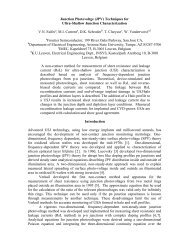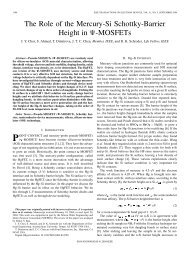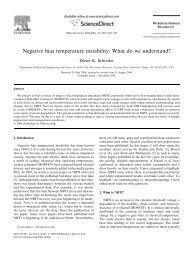ECS Transactions 3, (4), 321-337 (2006) - Dieter Schroder - Arizona ...
ECS Transactions 3, (4), 321-337 (2006) - Dieter Schroder - Arizona ...
ECS Transactions 3, (4), 321-337 (2006) - Dieter Schroder - Arizona ...
You also want an ePaper? Increase the reach of your titles
YUMPU automatically turns print PDFs into web optimized ePapers that Google loves.
<strong>ECS</strong> <strong>Transactions</strong> 3, (4), <strong>321</strong>-<strong>337</strong> (<strong>2006</strong>)<br />
Knowing the laser generation rate G’ and the sample thickness d, the effective lifetime<br />
is<br />
d∆n<br />
τ<br />
eff<br />
=<br />
[6]<br />
G'<br />
where G’=(1-R)Φ, R is the reflectivity and Φ the photon flux density. A two-dimensional<br />
lifetime map obtained in 50 s with this technique is shown in Fig. 4. No scanning is required,<br />
since both black body and excitation laser are broad area sources, covering the<br />
entire sample. The black body emits over a wide wavelength range. The peak wavelength<br />
occurs at<br />
3000<br />
λ peak<br />
≈ µ m<br />
[7]<br />
T<br />
A hot plate at T=350 K has its peak wavelength at λ peak ≈8.6 µm - a very suitable wavelength<br />
for free carrier absorption measurements. Just as carriers absorb IR radiation, they<br />
also emit IR radiation. According to Kirchhoff’s law they emit the same power as they<br />
absorb to remain at a given temperature. Hence, if the black body source is absent, the<br />
sample itself will emit IR radiation and can be used to determine the lifetime. The sample<br />
is still excited with a laser and the difference signal is acquired as in the transmission system.<br />
Both emission and absorption have been used for lifetime measurements. 15<br />
Figure 4. Free carrier absorption minority carrier lifetimes of a multicrystalline Si wafer<br />
with 350 µm lateral resolution. After Isenberg at al. ref. 14.<br />
Photoluminescence (PL) has most commonly been used at low temperatures for impurity<br />
identification and for determining low doping densities (N A,D ≤ 10 12 cm -3 ) in Si. 16 Recently,<br />
a PL-based new commercial tool, SiPHER, has been introduced, operating at<br />
room temperature with two wavelengths λ = 532 nm and 827 nm with optical penetration<br />
depths of 1.25 and 12.5 µm. 17 It measures PL and the reflectance and has found application<br />
to detect defects (dislocations, oxygen precipitates, metallic contamination) and doping<br />
density striations in silicon wafers. 18 Example PL maps and doping density striations<br />
are shown in Figs. 5-7, illustrating the versatility of the technique.<br />
Figure 5 shows doping striations of an epitaxial layer on a heavily-doped substrate at<br />
the two wavelengths. The higher-wavelength, shorter-penetration depth light samples<br />
mainly the epi layer with quite uniform doping density. However, the lower-wavelength,<br />
higher-penetration depth measurement samples the substrate and clearly shows doping<br />
density striations. Figure 6 shows metallic contamination from an epitaxial deposition<br />
326








